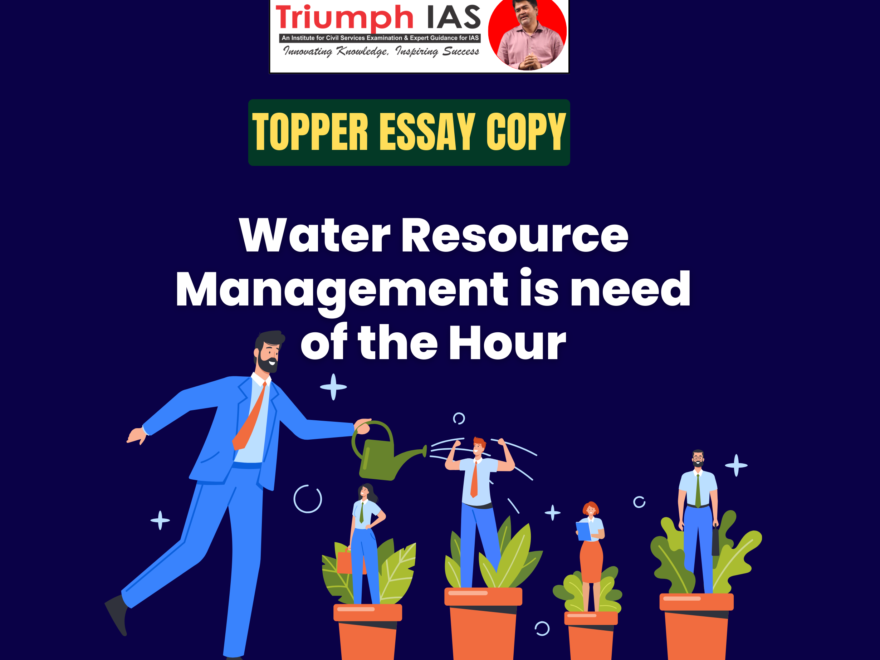Water Resource Management is need of the Hour
There are several spelling mistakes in the content provided. Here is the corrected version without changing the length and format:
There is a famous Arabian tale of a Merchant who was traveling amidst the hot desert in scorching summer. In the path, he found a thousand gold coins spread in sand. With no place to store them after his pockets were full with just 200 coins, he emptied his jug of water in greed of gold. He forgot the importance of precious water resource. He was barely able to walk 10 miles and died of dehydration.
Let us assume the status quo of present water use practices and take a time lapse to 2100. Well, we might not be alive at that time, but just imagine the life of future generations. On waking up, they won’t have the luxury of washing up mouth with fresh cool water, neither for tooth polishing, nor for bathing. Only thing they have is to drink 8 glasses a day with each costing up to 100$/glass. Who would like to live in such a world? Now, wake up! To avoid all this, time to act is now.
In this essay, we will assess the mammoth water crisis in front of us, what are the faulty practices that are responsible for this. Also, we will see some easy & feasible solutions to solve the problem in a sustainable manner.
Water, water everywhere, but not a drop to spare.
Almost 75% area of Earth is covered with water, out of which only <1.k is useful clean water source for human use. On this 1%, feed the population of 7.5 billion. But for India, the situation is more serious which shares 20% of the world population but just 4% of fresh water resources.
Today, the world is realizing the force of water which, coupled with climate change, results in multi-faceted problems of floods, droughts, cyclones, etc., and causes loss of trillions of dollars every year. Yet, the world is behaving like a pigeon with closed eyes in front of eat.
It is an inherent nature of human beings that they realize the utility of something only when it is scarce. Historically, the Indus Valley Civilization and the great Kakatiya dynasty embraced the usefulness of water & built water reservoirs & harvesting practices. In Vedic age, our saints worshipped it as Varuna Deva. After all, what is there without it, only 5 days of life.
But with the advent of technology and exploration of new fresh water resources, we forgot its importance & took it for granted & used it irrationally. The outcome is in front of us.
There are several spelling mistakes in the content provided. Here is the corrected version without changing the length and format:
There is a famous Arabian tale of a Merchant who was traveling amidst the hot desert in scorching summer. In the path, he found a thousand gold coins spread in sand. With no place to store them after his pockets were full with just 200 coins, he emptied his jug of water in greed of gold. He forgot the importance of precious water resource. He was barely able to walk 10 miles and died of dehydration.
Let us assume the status quo of present water use practices and take a time lapse to 2100. Well, we might not be alive at that time, but just imagine the life of future generations. On waking up, they won’t have the luxury of washing up mouth with fresh cool water, neither for tooth polishing, nor for bathing. Only thing they have is to drink 8 glasses a day with each costing up to 100$/glass. Who would like to live in such a world? Now, wake up! To avoid all this, time to act is now.
In this essay, we will assess the mammoth water crisis in front of us, what are the faulty practices that are responsible for this. Also, we will see some easy & feasible solutions to solve the problem in a sustainable manner.
Water, water everywhere, but not a drop to spare.
Almost 75% area of Earth is covered with water, out of which only <1.k is useful clean water source for human use. On this 1%, feed the population of 7.5 billion. But for India, the situation is more serious which shares 20% of the world population but just 4% of fresh water resources.
Today, the world is realizing the force of water which, coupled with climate change, results in multi-faceted problems of floods, droughts, cyclones, etc., and causes loss of trillions of dollars every year. Yet, the world is behaving like a pigeon with closed eyes in front of eat.
It is an inherent nature of human beings that they realize the utility of something only when it is scarce. Historically, the Indus Valley Civilization and the great Kakatiya dynasty embraced the usefulness of water & built water reservoirs & harvesting practices. In Vedic age, our saints worshipped it as Varuna Deva. After all, what is there without it, only 5 days of life.
But with the advent of technology and exploration of new fresh water resources, we forgot its importance & took it for granted & used it irrationally. The outcome is in front of us.
Today, agriculture accounts for the maximum use of fresh water use, approximately 80% as per NITI Aayog Report. With subsidies & Green Revolution & pursuit of high productivity they flooded their field with water. It not only resulted in the downfall of Groundwater Table but also resulted in land degradation, erosion & salivation.
Inter-county & Inter-state rivalry also took over the domain of water. Diverting Water & building large dams upstream to make the other county negotiate led not only political struggle but also broke the natural flow & availability affected the biodiversity & riverine ecosystem & caused floods & droughts. Today, Goddess Ganga is no more ‘Aviral & Nirmal’.
The growing problem of wastewater discharge from big industries & households just to save processing costs degraded the ecosystem health. Also, plastics are flooding the oceans. As per UN Water Report, there will be more plastics in the ocean than fishes by 2050.
Social norms are equally responsible for water crisis. Practices of open defecation have contaminated the water reservoirs. In UP almost 65% of faecal sludge finds its place in water reservoirs. Their incarnation as goddess & festival rituals of throwing up Idols, and diyas; and ritual of ‘Ganga Asthivisarjan’ also affected the health of riverine ecosystem.
Due to climate change, glaciers are melting at an alarming rate and so the fresh water resources are depleting. Excessive use of fertilizers has led to eutrophication which converts the water resources into grasslands. Urban areas with concrete structures provide little space for rainwater to seep into the ground. As per NITI Aayog report, 20 major cities of India will run out of groundwater by 2020.
But given the large size of problem conservation P, we must act foot and that two in a holistic manner. There are a lot of proven practices to conserve water. For example – Israel and Johannesburg resource & entered water security.
Presently, India harvests only 8% of rainwater. Chennai, where it is mandatory to have rainwater harvesting structure though took bold step but implementation efficiencies didn’t bear the right fruit. Proper utilization of Lord Indra rainfall can be a great way to overcome this havoc.
The principle of 3R – Reduce, recycle, Reuse can take us an “extra mile in path to sustainable conservation. Use of domestic grey water in watering creep & plants and groundwater revenge will significantly decrease water demand.
Ramping up STC (sewage treatment Capacity) which is presently at 36% will put forward the circular economy. This treated water can be reused in industry, for groundwater recharge & for agricultural purposes. Also, the bad effects on biodiversity will be decreased.
Singapore has an innovative system of separating drainage & sewage lines. This even reduced The treatment costs. Israel mastered the practices of drip irrigation & bloomed the deserts. Saudi Arabia put up large desalination plants and got controlled the mater crises problem. All these practices can be replicated throughout the world.
India’s Swachh Bharat Mission, under which 98% of county’s area is declared ODF free was rewarded by UN Water with prestigious prize. Also, River basin Level Management practices with decentralized governance by local bodies will be a big leap for effective conservation. India’s Neeranchal programme & Mission Ganga embrace the same principle.
Phunsukh Wangdu, the real hero of 3 Idiots got innovative practices of storing water in large artificial ice mountains in Ladakh Area. He even replicated this in Switzerland, Norway. Also, clean seas initiative of NGO to remove plastics from ocean received global best effort award.
We also need to take lessons from our ancient wisdom. Reviving the old water reservoirs & studying conservation practices will bring a great milieu with new technology. NREGA programme Can be used to build new water holding structures.
As highlighted by PMO India in his independence speech, the solution to problem lies in behavioral change & requires a Jan Andolan (people movement). It is time that people realize the true value of precious resource & change their lifestyle in a sustainable manner. Only then we can achieve SDG 6. Govt. programme of Jal Shakti Abhiyan & # Jan Shakti 4 Jal Shakti should be pursued with great enthusiasm.
The world has to realize that it is a global common problem not limited to territorial boundaries. Spillover effects like Migration, ocean water rise can cause World War III.
With all nations standing up together with firm resolution, it will be just a matter of time that we will again be back in equilibrium with earth water resource capacity and live a sustainable life. Future generations are counting upon
With subsidies & Green Revolution & pursuit of high productivity they flooded their field with water. It not only resulted in the downfall of Groundwater Table but also resulted in land degradation, erosion & salivation.
Inter-county & Inter-state rivalry also took over the domain of water. Diverting Water & building large dams upstream to make the other county negotiate led not only political struggle but also broke the natural flow & availability affected the biodiversity & riverine ecosystem & caused floods & droughts. Today, Goddess Ganga is no more ‘Aviral & Nirmal’.
The growing problem of wastewater discharge from big industries & households just to save processing costs degraded the ecosystem health. Also, plastics are flooding the oceans. As per UN Water Report, there will be more plastics in the ocean than fishes by 2050.
Social norms are equally responsible for water crisis. Practices of open defecation have contaminated the water reservoirs. In UP almost 65% of faecal sludge finds its place in water reservoirs. Their incarnation as goddess & festival rituals of throwing up Idols, and diyas; and ritual of ‘Ganga Asthivisarjan’ also affected the health of riverine ecosystem.
Due to climate change, glaciers are melting at an alarming rate and so the fresh water resources are depleting. Excessive use of fertilizers has led to eutrophication which converts the water resources into grasslands. Urban areas with concrete structures provide little space for rainwater to seep into the ground. As per NITI Aayog report, 20 major cities of India will run out of groundwater by 2020.
But given the large size of problem conservation P, we must act foot and that two in a holistic manner. There are a lot of proven practices to conserve water. For example – Israel and Johannesburg resource & entered water security.
Presently, India harvests only 8% of rainwater. Chennai, where it is mandatory to have rainwater harvesting structure though took bold step but implementation efficiencies didn’t bear the right fruit. Proper utilization of Lord Indra rainfall can be a great way to overcome this havoc.
The principle of 3R – Reduce, recycle, Reuse can take us an “extra mile in path to sustainable conservation. Use of domestic grey water in watering creep & plants and groundwater revenge will significantly decrease water demand.
Ramping up STC (sewage treatment Capacity) which is presently at 36% will put forward the circular economy. This treated water can be reused in industry, for groundwater recharge & for agricultural purposes. Also, the bad effects on biodiversity will be decreased.
Singapore has an innovative system of separating drainage & sewage lines. This even reduced The treatment costs. Israel mastered the practices of drip irrigation & bloomed the deserts. Saudi Arabia put up large desalination plants and got controlled the mater crises problem. All these practices can be replicated throughout the world.
India’s Swachh Bharat Mission, under which 98% of county’s area is declared ODF free was rewarded by UN Water with prestigious prize. Also, River basin Level Management practices with decentralized governance by local bodies will be a big leap for effective conservation. India’s Neeranchal programme & Mission Ganga embrace the same principle.
Phunsukh Wangdu, the real hero of 3 Idiots got innovative practices of storing water in large artificial ice mountains in Ladakh Area. He even replicated this in Switzerland, Norway. Also, clean seas initiative of NGO to remove plastics from ocean received global best effort award.
We also need to take lessons from our ancient wisdom. Reviving the old water reservoirs & studying conservation practices will bring a great milieu with new technology. NREGA programme Can be used to build new water holding structures.
As highlighted by PMO India in his independence speech, the solution to problem lies in behavioral change & requires a Jan Andolan (people movement). It is time that people realize the true value of precious resource & change their lifestyle in a sustainable manner. Only then we can achieve SDG 6. Govt. programme of Jal Shakti Abhiyan & # Jan Shakti 4 Jal Shakti should be pursued with great enthusiasm.
The world has to realize that it is a global common problem not limited to territorial boundaries. Spillover effects like Migration, ocean water rise can cause World War III.
With all nations standing up together with firm resolution, it will be just a matter of time that we will again be back in equilibrium with earth water resource capacity and live a sustainable life.
|







